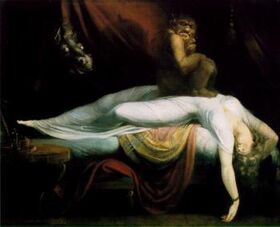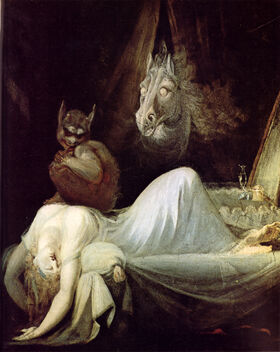Assessment |
Biopsychology |
Comparative |
Cognitive |
Developmental |
Language |
Individual differences |
Personality |
Philosophy |
Social |
Methods |
Statistics |
Clinical |
Educational |
Industrial |
Professional items |
World psychology |
Clinical: Approaches · Group therapy · Techniques · Types of problem · Areas of specialism · Taxonomies · Therapeutic issues · Modes of delivery · Model translation project · Personal experiences ·
In common current usage, the term nightmare refers to dreams of particular intensity, with content that the sleeper finds disturbing, related either to physiological causes, such as a high fever, or to psychological ones, such as unusual trauma or stress in the sleeper's life. The occasional body movements seen in nightmares may have a use in awakening the sleeper, thus helping to avoid the frightening dream-situation.
Occasional nightmares are commonplace, but recurrent nightmares can interfere with sleep and may cause people to seek medical help. A recently proposed treatment consists of imagery rehearsal (PMID 15984916). This approach appears to reduce the effects of nightmares and other symptoms in acute stress disorder and post-traumatic stress disorder[1].
Historic use of term

The Nightmare, Henry Fuseli, 1781 (The Detroit Institute of Arts, Detroit)
Nightmare was the original term for the state later known as waking dream (cf Mary Shelley and Frankenstein's Genesis), and more currently as sleep paralysis, associated with rapid eye movement (REM) periods of sleep. The original definition was codified by Dr Johnson in his Dictionary and was thus understood, among others by Erasmus Darwin and Henry Fuseli, to include a "morbid oppression in the night, resembling the pressure of weight upon the breast."
Such nightmares were widely considered to be the work of demons, which were thought to sit on the chests of sleepers. In Old English, the being in question was called a mare or mære (from a proto-Germanic *marōn, related to Old High German and Old Norse mara), whence comes the mare part in nightmare.
This type of waking dream is called mareridt in Danish, cauchemar in French, pesadilla in Spanish, Alpdruck or Alptraum in German, incubo in Italian, pesadelo in Portuguese and kanashibari in Japanese.

The Nightmare, Henry Fuseli, 1802 (Frankfurter Goethe-Museum, Frankfurt)
Various forms of magic and spiritual possession were also advanced as causes. In nineteenth century Europe, the vagaries of diet were thought to be responsible. For example, in Charles Dickens's A Christmas Carol Ebenezer Scrooge attributes the ghost he sees to "... an undigested bit of beef, a blot of mustard, a crumb of cheese, a fragment of an underdone potato..." In a similar vein, the Household Cyclopedia (1881), offers the following advice about nightmares:
- "Great attention is to be paid to regularity and choice of diet. Intemperance of every kind is hurtful, but nothing is more productive of this disease than drinking bad wine. Of eatables those which are most prejudicial are all fat and greasy meats and pastry... Moderate exercise contributes in a superior degree to promote the digestion of food and prevent flatulence; those, however, who are necessarily confined to a sedentary occupation, should particularly avoid applying themselves to study or bodily labor immediately after eating... Going to bed before the usual hour is a frequent cause of night-mare, as it either occasions the patient to sleep too long or to lie long awake in the night. Passing a whole night or part of a night without rest likewise gives birth to the disease, as it occasions the patient, on the succeeding night, to sleep too soundly. Indulging in sleep too late in the morning, is an almost certain method to bring on the paroxysm, and the more frequently it returns, the greater strength it acquires; the propensity to sleep at this time is almost irresistible."
See also
- Sleep disorder
- Night terror
- Sleep paralysis
- Mara (folklore)
- Nightmare on Elm Street
- Hag
Notes
- Max Eastman visited Sigmund Freud's apartment in Vienna, in 1926. He saw a print of Fuseli's The Nightmare, next to Rembrandt's The Anatomy Lesson. Ernest Jones chose another version of Fuseli's painting as the frontispiece of his book On the Nightmare, however neither Freud nor Jones mentioned those paintings in their writings about the classic nightmare.
- Upcoming exhibit: Gothic Nightmares: Fuseli, Blake and the Romantic Imagination. 15 February – 1 May (2006); Tate Britain, Millbank, London SW1P 4RG.
- When considered a disease, nightmares are classified as follows:
- ICD-10 code = F51.5
- ICD-9 code = 307.47
References
- Anch, A.M., & Browman, C.P., & Mitler, M.M., & Walsh, J.K. (1988). Sleep: A scientific perspective. New Jersey: Prentice-Hall, Inc.
- Harris J.C. (2004). Arch Gen Psychiatry. May;61(5):439-40. The Nightmare. (PMID 15123487)
- Jones, Ernest (1951). On the Nightmare (ISBN: 0871409127) (pbk, 1971; ISBN: 0871402483).
- Powell, Nicolas (1973). Fuseli: The Nightmare (ISBN:0713902744).
- Forbes, D. et al. (2001) Brief Report: Treatment of Combat-Related Nightmares Using Imagery Rehearsal: A Pilot Study, Journal of Traumatic Stress 14 (2): 433-442
- Siegel, A. (2003) A mini-course for clinicians and trauma workers on posttraumatic nightmares.
- Burns, Sarah (2004). Painting the Dark Side : Art and the Gothic Imagination in Nineteenth-Century America. Ahmanson-Murphy Fine Are Imprint, 332 pp, University of California Press, ISBN: 0520238214.
- Davenport-Hines, Richard (1999). Gothic: Four Hundred Years of Excess, Horror, Evil and Ruin. North Point Press, p160-61.
- Simons, Ronald C and Hughes, Charles C (eds.)(1985). Culture-Bound Syndromes. Springer, 536pp.
- Sagan, Carl (1997). The Demon-Haunted World: Science as a Candle in the Dark .
External links
de:Albtraum es:Pesadilla eo:Koŝmaro fr:Cauchemar nl:Nachtmerrie pt:Pesadelo fi:Painajainen sv:Mardröm zh:恶梦
| This page uses Creative Commons Licensed content from Wikipedia (view authors). |